Welcome to our article on the importance of Architecture for Long-Term Sustainability. As we face increasing environmental challenges, the need for sustainable architecture has become more crucial than ever. Sustainable architecture not only reduces environmental impact but also promotes occupant health and well-being while reducing long-term costs. In this article, we will explore the key principles of sustainable architecture, green building practices, and renewable materials used in construction. We will also showcase inspiring examples of architecture for long-term sustainability and demonstrate how sustainable urban planning can create a more sustainable future.
Key Takeaways
- Architecture for Long-Term Sustainability is essential in the face of increasing environmental challenges.
- Sustainable architecture principles include reducing environmental impact, optimizing energy efficiency, and promoting sustainable materials and construction methods.
- Green building practices such as using renewable materials, implementing energy-efficient design strategies, and incorporating sustainable urban planning principles can help create a more sustainable future.
- Renewable materials play an essential role in sustainable construction, and their use can lead to significant benefits.
Understanding Sustainable Architecture
Today’s architectural trends are shifting towards sustainability and eco-friendliness, in an effort to combat the environmental challenges faced by the world today. Sustainable architecture is an environmentally conscious approach that optimizes energy efficiency and focuses on reducing the use of non-renewable resources. By adopting sustainable architecture principles, architects and builders can ensure that their designs are not only aesthetically pleasing, but also ecologically responsible.
Key Principles of Sustainable Architecture
Sustainable architecture consists of a range of design concepts and techniques, each aimed at reducing the environmental impact of the built environment. These principles include:
- Optimizing energy efficiency by reducing the energy consumption of the building through passive cooling and heating techniques, eco-friendly insulation, and sustainable lighting and appliances.
- Using sustainable materials and construction techniques that minimize the use of non-renewable resources, and instead relying on renewable materials such as bamboo, recycled steel, and bricks made from waste materials.
- Maximizing indoor environment quality through the use of natural lighting and ventilation, and careful selection of building materials that do not emit harmful toxins into the environment.
- Designing buildings that are adaptable and can be modified over time, reducing the need for demolition and reconstruction.
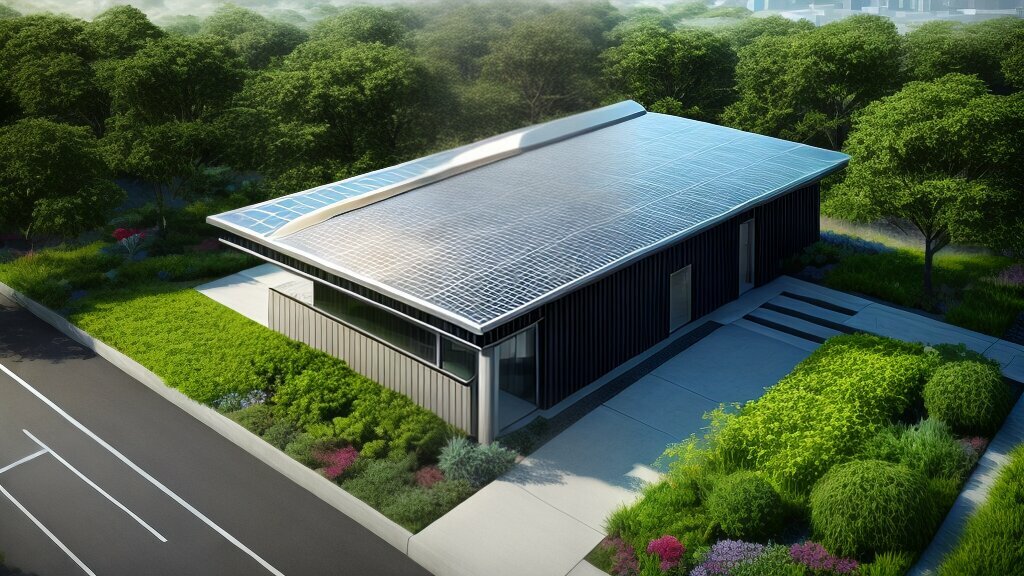
“Sustainability is not about finding new ways to do old things; it is about finding new ways of doing new things.” – Cameron Sinclair
Benefits of Sustainable Architecture
Aside from the environmental benefits of sustainable architecture, there are many other advantages to adopting this approach. Buildings constructed using sustainable architecture principles are typically more energy-efficient, leading to lower operating costs and improved tenant satisfaction. They also promote healthier lifestyles, with better indoor air quality and increased access to natural light and open spaces. Finally, sustainable architecture offers long-term economic benefits, with lower maintenance and repair costs and higher resale values.
Green Building Practices
Incorporating green building practices is essential for sustainable architecture. Green building practices involve using renewable materials, implementing energy-efficient design strategies and incorporating sustainable urban planning principles.
Renewable Materials
| Materials |
Benefits |
| Bamboo |
Fast-growing, renewable, and durable |
| Recycled Steel |
Recyclable, strong, and long-lasting |
| Straw Bales |
Renewable, inexpensive, and provide excellent insulation |
These are just a few examples of renewable materials that can be used in sustainable construction. Using renewable materials not only reduces the carbon footprint but also saves money in the long run.
Energy-Efficient Design Strategies
Energy-efficient design strategies aim to use less energy while still meeting human needs. Passive design strategies, such as good insulation, natural ventilation, and shading devices, can reduce energy consumption. Smart building systems can monitor and control energy usage. Integration of renewable energy sources, such as solar panels and wind turbines, can help to generate electricity on-site.
Using energy-efficient design strategies significantly reduces emissions while still maintaining a comfortable and healthy environment for occupants.
Sustainable Urban Planning Principles
Sustainable urban planning principles aim to create a more eco-friendly and livable city. Mixed-use development, walkability, public transportation, and green spaces are some examples. Mixed-use development reduces the need for a car, while walkability and public transportation reduce carbon emissions. Green spaces improve air quality and provide recreational areas for residents.
By incorporating sustainable urban planning principles, we can create more sustainable and livable cities, while also reducing the carbon footprint of urban areas.
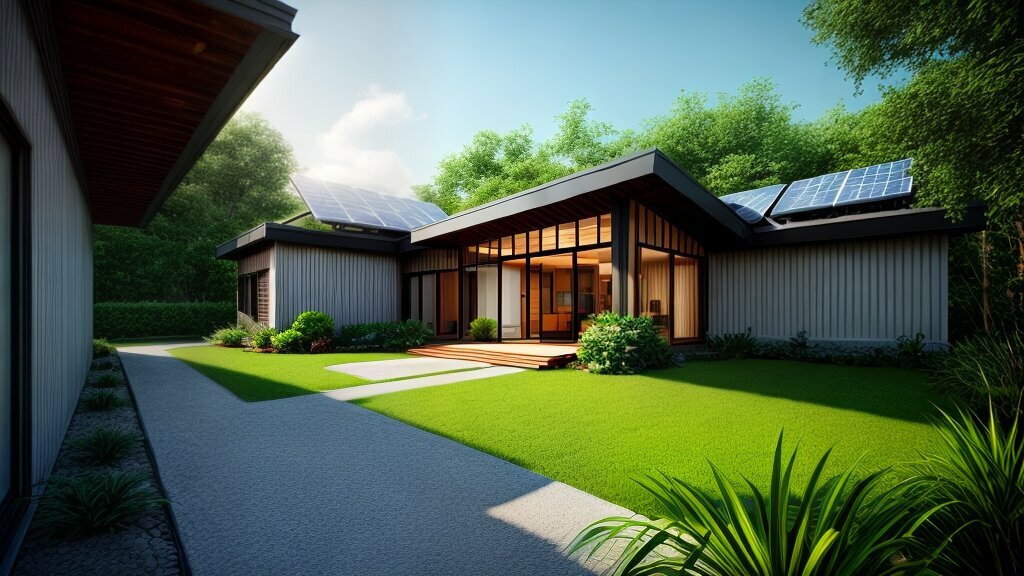
The Role of Renewable Materials in Sustainable Construction
Renewable materials are essential to achieving sustainable construction. They have a lower environmental impact than traditional construction materials and promote long-term sustainability by reducing energy consumption and waste.
Benefits of using renewable materials:
- They are biodegradable and have a smaller carbon footprint than conventional building materials.
- They are durable, low maintenance, and can reduce energy consumption in buildings.
- They promote responsible sourcing and a circular economy, reducing waste and conserving resources.
Examples of renewable materials commonly used in construction include:
| Material |
Description |
| Bamboo |
A fast-growing, renewable grass that can be used for flooring, walls, and furniture. |
| Reclaimed wood |
Salvaged wood from old buildings or structures that can be repurposed for flooring, beams, and furniture. |
| Rammed earth |
A natural building material made by compacting earth or other materials in layers to create walls. |
| Cork |
A renewable, lightweight material that can be used for flooring, insulation, and wall panels. |
By incorporating renewable materials into the design and construction process, sustainable buildings can be created that are not only environmentally friendly but also aesthetically appealing and cost-effective. For example, the Bullitt Center in Seattle is one of the greenest commercial buildings in the world, featuring a range of renewable materials such as salvaged wood, cross-laminated timber, and triple-paned windows.
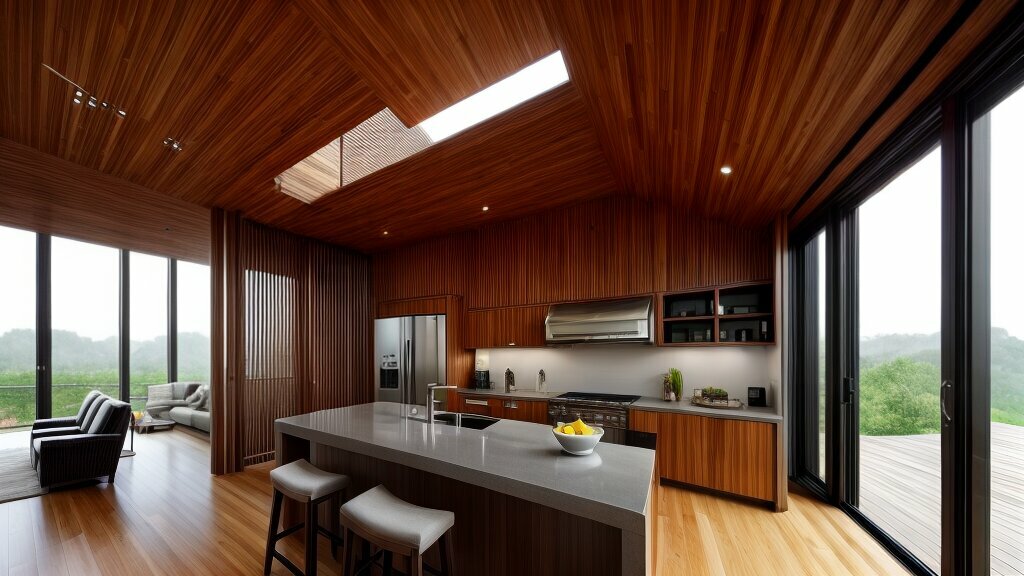
“Sustainability is not a buzzword. It’s the only way to ensure a healthy future for ourselves and the planet. Renewable materials are an essential component of sustainable construction, and their use should be embraced by architects, builders, and policymakers to create a more sustainable built environment.”
Energy-Efficient Building Design
One of the main principles of sustainable architecture is to optimize energy efficiency, which can be achieved through energy-efficient building design strategies. Passive design techniques aim to reduce the need for artificial heating and cooling, while smart building systems use sensors and automation to optimize energy use. Integration of renewable energy sources, such as solar panels or wind turbines, can further reduce reliance on non-renewable energy sources.

Passive design strategies include maximizing natural lighting and ventilation, using shading devices to reduce heat gain, and incorporating thermal mass in building materials to regulate indoor temperature. Smart building systems use sensors to monitor and control energy use, adjusting lighting and HVAC systems based on occupancy and ambient conditions. Integration of renewable energy sources can provide a reliable source of clean energy, reducing reliance on non-renewable sources.
Energy-efficient building design not only reduces environmental impact but can also lead to significant cost savings over the long term. Improved insulation and reduced energy use can result in lower utility bills, while the integration of renewable energy sources can provide a reliable source of energy with a known cost.
Sustainable Urban Planning
Sustainable urban planning is an essential component of creating long-term sustainability in the built environment. The growing population and increasing urbanisation have led to a rise in environmental challenges, which can be addressed through eco-friendly building design and sustainable construction methods.
Mixed-use development is a key strategy in sustainable urban planning, as it promotes the efficient use of land and reduces the need for long-distance transportation. Walkability is another important aspect, which encourages people to walk or cycle instead of driving, reducing traffic congestion and air pollution. Public transportation is also a crucial element in sustainable urban planning, providing people with convenient and eco-friendly means of transportation.
Green spaces, such as parks and public gardens, are critical in creating a healthy and sustainable urban environment. They provide essential ecosystem services, such as air purification, reducing the urban heat island effect, and improving overall mental and physical health.
Moreover, sustainable urban planning can be achieved through the use of eco-friendly building design principles, such as designing buildings to be energy-efficient, using renewable materials in construction, and optimizing indoor environmental quality.
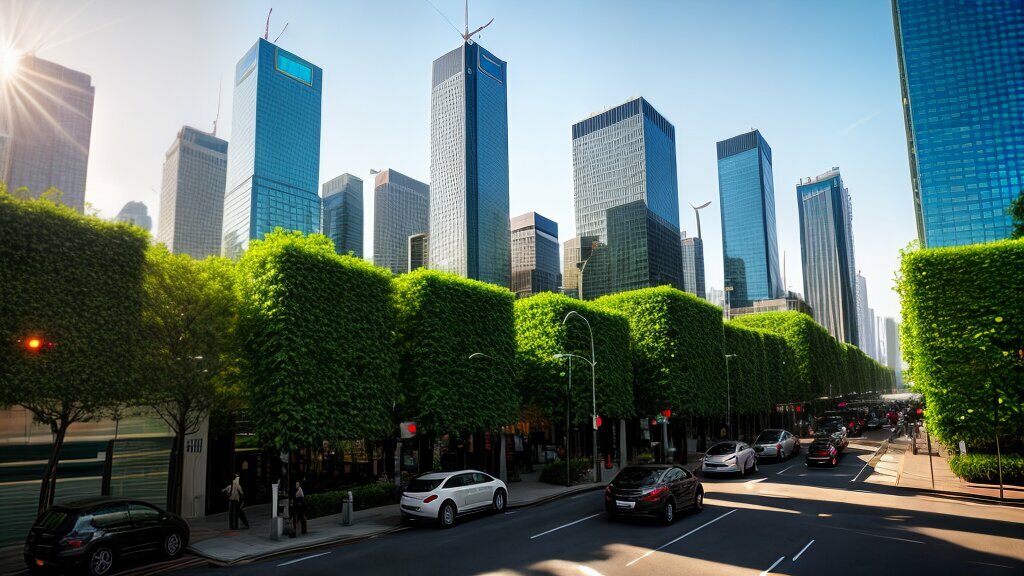
“Cities have the capability of providing something for everybody, only because, and only when, they are created by everybody.” – Jane Jacobs
The Benefits of Architecture for Long-Term Sustainability
Adopting sustainable architecture practices can have numerous benefits beyond reducing environmental impact. Let’s take a look at some of the most significant advantages:
| Benefit |
Description |
| Improved occupant health and well-being |
Sustainable buildings are designed with the health and comfort of occupants in mind, incorporating features like natural lighting, improved air quality, and noise reduction. |
| Long-term cost savings |
Sustainable buildings often have lower operating costs due to reduced energy consumption and maintenance needs, resulting in long-term financial savings for building owners and occupants. |
| Increased property value |
Sustainable buildings are becoming increasingly desirable and marketable as more people become aware of the benefits of eco-friendly buildings. |
| Reduced environmental impact |
By incorporating sustainable practices and materials, sustainable buildings have a lower environmental impact, reducing carbon emissions and waste production. |
These benefits make it clear that architecture for long-term sustainability is not only good for the environment but also for the wellbeing and financial prosperity of building occupants and owners.
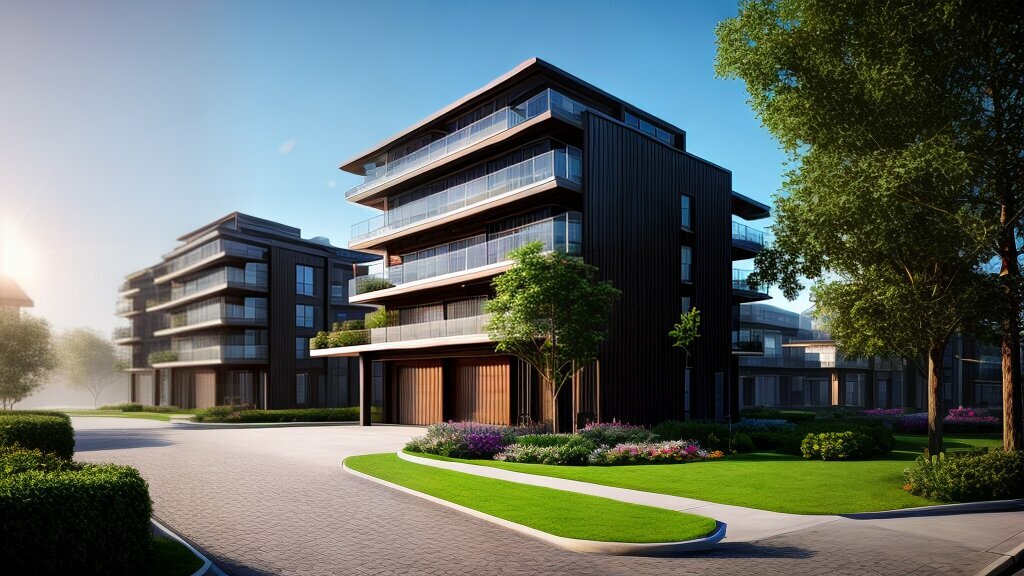
Image Source: seowriting.ai
Case Studies: Inspiring Examples of Sustainable Architecture
Inspiration can come from many sources, including real-life examples of outstanding sustainable architecture projects that have successfully implemented eco-friendly building design and sustainable construction methods. Here are a few examples of how architecture for long-term sustainability can be achieved:
One Angel Square, Manchester, UK
 One Angel Square is the headquarters of the Co-operative Group, and is widely regarded as one of the most sustainable buildings in Europe. The building features a range of sustainable design features, including the use of renewable materials in construction, energy-efficient lighting, and a combined heat and power system that reduces carbon emissions by up to 80%. The building has won numerous awards for its sustainability credentials, including the BREEAM Outstanding rating, the highest possible environmental assessment rating.
One Angel Square is the headquarters of the Co-operative Group, and is widely regarded as one of the most sustainable buildings in Europe. The building features a range of sustainable design features, including the use of renewable materials in construction, energy-efficient lighting, and a combined heat and power system that reduces carbon emissions by up to 80%. The building has won numerous awards for its sustainability credentials, including the BREEAM Outstanding rating, the highest possible environmental assessment rating.
The Edge, Amsterdam, NL
 The Edge is a 40,000 square metre office building in Amsterdam that is widely considered to be the smartest building in the world. The building incorporates a range of cutting-edge technologies, including a smart lighting system that adjusts to individual preferences, motion sensors that detect when and where people are in the building, and a smartphone app that allows employees to personalize their working environment. The building also features a range of sustainable design features, including energy-efficient building design, solar panels that generate more energy than the building consumes, and a rainwater collection system that reduces water consumption by up to 75%.
The Edge is a 40,000 square metre office building in Amsterdam that is widely considered to be the smartest building in the world. The building incorporates a range of cutting-edge technologies, including a smart lighting system that adjusts to individual preferences, motion sensors that detect when and where people are in the building, and a smartphone app that allows employees to personalize their working environment. The building also features a range of sustainable design features, including energy-efficient building design, solar panels that generate more energy than the building consumes, and a rainwater collection system that reduces water consumption by up to 75%.
The Bullitt Center, Seattle, USA
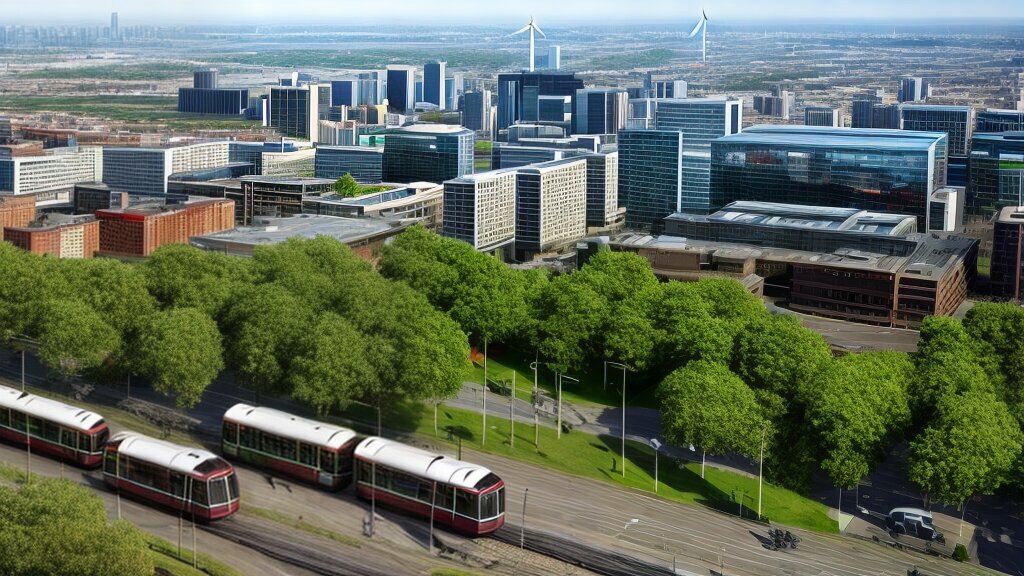 The Bullitt Center is a six-story office building in Seattle that is widely regarded as one of the most sustainable commercial buildings in the world. The building incorporates a range of sustainable design features, including triple-glazed windows that minimize heat loss and noise pollution, a rainwater collection system that provides 100% of the building’s water needs, and a composting toilet system that eliminates the need for conventional sewage treatment. The building also features sustainable urban planning elements, including a location near public transportation, bike storage, and electric vehicle charging stations.
The Bullitt Center is a six-story office building in Seattle that is widely regarded as one of the most sustainable commercial buildings in the world. The building incorporates a range of sustainable design features, including triple-glazed windows that minimize heat loss and noise pollution, a rainwater collection system that provides 100% of the building’s water needs, and a composting toilet system that eliminates the need for conventional sewage treatment. The building also features sustainable urban planning elements, including a location near public transportation, bike storage, and electric vehicle charging stations.
These examples demonstrate that sustainable architecture is not only possible, but also can be aesthetically appealing and functionally efficient. By adopting architecture for long-term sustainability, we can create a more sustainable future for generations to come.
Conclusion
In conclusion, sustainable architecture is pivotal in creating a more environmentally conscious future. By reducing the environmental impact of buildings, optimizing energy efficiency and promoting sustainable materials and construction methods, architecture can play a significant role in addressing the challenges faced by our planet.
Adopting architecture for long-term sustainability offers numerous benefits, including improved occupant health and well-being, reduced environmental impact and long-term cost savings. It is crucial that we make this a priority in all future construction projects, to ensure we are building for future generations.
Let’s Build a Sustainable Future
We have seen inspiring examples of sustainable architecture projects that are leading the way in eco-friendly building design and sustainable construction methods. By embracing these practices, we can create a more sustainable future for all.
It is up to architects, builders and developers to take responsibility for the impact of their buildings on the environment, and to prioritize the use of renewable materials, energy-efficient design strategies and sustainable urban planning principles.
Architecture for long-term sustainability is more than just a concept, it is a necessity. By working together, we can create buildings that not only meet our immediate needs, but also leave a positive impact on the planet for years to come.
FAQ
Q: What is sustainable architecture?
A: Sustainable architecture refers to the practice of designing and constructing buildings that have a minimal negative impact on the environment. It involves utilizing energy-efficient design strategies, promoting the use of sustainable materials, and reducing overall environmental footprint.
Q: What are some key principles of sustainable architecture?
A: Key principles of sustainable architecture include reducing environmental impact, optimizing energy efficiency, promoting sustainable materials and construction methods, and integrating with the surrounding environment.
Q: What are green building practices?
A: Green building practices encompass a range of environmentally-conscious practices and strategies aimed at reducing the environmental impact of construction and promoting sustainability. This can include using renewable materials, implementing energy-efficient design strategies, and incorporating sustainable urban planning principles.
Q: Why are renewable materials important in sustainable construction?
A: Renewable materials play a crucial role in sustainable construction as they have a lower environmental impact compared to non-renewable materials. They are sourced from sustainable resources and can be replenished over time, making them more environmentally friendly.
Q: What is energy-efficient building design?
A: Energy-efficient building design involves designing and constructing buildings that minimize energy consumption and maximize energy efficiency. This can be achieved through various strategies, such as passive design techniques, smart building systems, and the integration of renewable energy sources.
Q: What is sustainable urban planning?
A: Sustainable urban planning is the practice of designing cities and communities that promote environmental sustainability, social equity, and economic prosperity. It involves incorporating elements such as mixed-use development, walkability, public transportation, and green spaces.
Q: What are the benefits of adopting architecture for long-term sustainability?
A: Adopting architecture for long-term sustainability brings numerous benefits, including reduced environmental impact, improved occupant health and well-being, and long-term cost savings. It also helps create a more sustainable future for generations to come.
Q: Can you provide examples of sustainable architecture projects?
A: Certainly! There are many inspiring examples of sustainable architecture projects, including buildings that utilize passive design strategies, incorporate renewable energy sources, and make use of sustainable materials. These projects serve as inspiration for creating environmentally-friendly and innovative buildings.






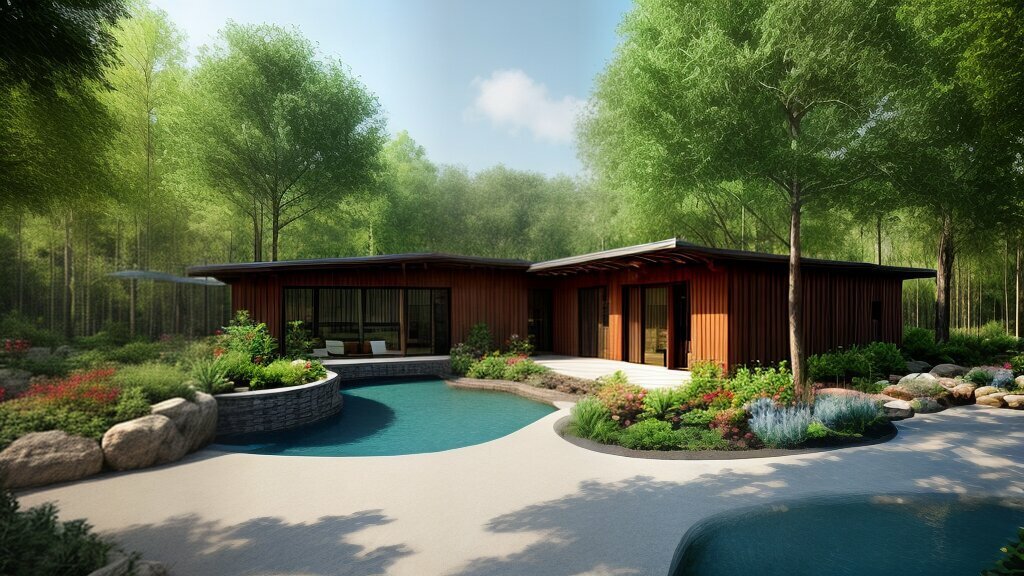






 One Angel Square is the headquarters of the Co-operative Group, and is widely regarded as one of the most sustainable buildings in Europe. The building features a range of sustainable design features, including the use of renewable materials in construction, energy-efficient lighting, and a combined heat and power system that reduces carbon emissions by up to 80%. The building has won numerous awards for its sustainability credentials, including the BREEAM Outstanding rating, the highest possible environmental assessment rating.
One Angel Square is the headquarters of the Co-operative Group, and is widely regarded as one of the most sustainable buildings in Europe. The building features a range of sustainable design features, including the use of renewable materials in construction, energy-efficient lighting, and a combined heat and power system that reduces carbon emissions by up to 80%. The building has won numerous awards for its sustainability credentials, including the BREEAM Outstanding rating, the highest possible environmental assessment rating. The Edge is a 40,000 square metre office building in Amsterdam that is widely considered to be the smartest building in the world. The building incorporates a range of cutting-edge technologies, including a smart lighting system that adjusts to individual preferences, motion sensors that detect when and where people are in the building, and a smartphone app that allows employees to personalize their working environment. The building also features a range of sustainable design features, including energy-efficient building design, solar panels that generate more energy than the building consumes, and a rainwater collection system that reduces water consumption by up to 75%.
The Edge is a 40,000 square metre office building in Amsterdam that is widely considered to be the smartest building in the world. The building incorporates a range of cutting-edge technologies, including a smart lighting system that adjusts to individual preferences, motion sensors that detect when and where people are in the building, and a smartphone app that allows employees to personalize their working environment. The building also features a range of sustainable design features, including energy-efficient building design, solar panels that generate more energy than the building consumes, and a rainwater collection system that reduces water consumption by up to 75%. The Bullitt Center is a six-story office building in Seattle that is widely regarded as one of the most sustainable commercial buildings in the world. The building incorporates a range of sustainable design features, including triple-glazed windows that minimize heat loss and noise pollution, a rainwater collection system that provides 100% of the building’s water needs, and a composting toilet system that eliminates the need for conventional sewage treatment. The building also features sustainable urban planning elements, including a location near public transportation, bike storage, and electric vehicle charging stations.
The Bullitt Center is a six-story office building in Seattle that is widely regarded as one of the most sustainable commercial buildings in the world. The building incorporates a range of sustainable design features, including triple-glazed windows that minimize heat loss and noise pollution, a rainwater collection system that provides 100% of the building’s water needs, and a composting toilet system that eliminates the need for conventional sewage treatment. The building also features sustainable urban planning elements, including a location near public transportation, bike storage, and electric vehicle charging stations.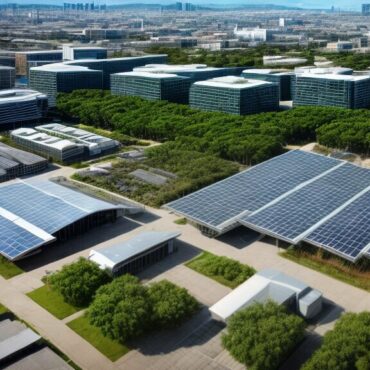










Post comments (0)